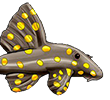| Scientific Name | Leporacanthicus cf. galaxias(l240) |
| Common Names | L240, Black Saum Vampire Pleco Northern Vampire Pleco, Orinoco Galaxy Pleco, Venezuela-galaksesugemalle (Denmark) |
| Pronunciation | lepor ah KAN thi cuss |
| Etymology | Latin, lepus, leporis = rabbit + Greek, akantha = thorn. |
| Size | 240mm or 9.4" SL. Find near, nearer or same sized spp. |
| Identification | All Leporacanthicus spp. have a small backwards facing slightly proud blunt thorn-like plate on top of their heads. This Venezuelan species is very similar to Leproacanthicus galaxias and may well turn out to represent the Northern limit of that species range. The unpaired fins of adult fish have very few or no spots at their tips giving the appearance of a black edge. |
| Sexing | Adult males have a much longer and broader head with small odontodes on the sides of head, more odontodes on pectoral fin spine and on the whole body, a bigger dorsal fin and normally a prettier coloration. The characteristic spine protruding from the top of the head is also said to be longer in males. |
| Distribution | Venezuela: Amazonas: Upper Orinoco Orinoco, Upper Orinoco (click on these areas to find other species found there) Login to view the map. |
| Temperature | 28.0-31.0°C or 82.4-87.8°F (Show species within this range) |
| Feeding | Not a true vegetarian so a wide variety of foods, including algae wafers, cucumber or courgette (zuchini), frozen bloodworm, prawns, shrimps and tablet food. Shelled crustaceans or molluscs appear favourite foods but should be fed sparingly or used for conditioning. User data. |
| Furniture | Prefers bogwood and darker rocks. |
| Compatibility | Gets on with small lively catfish but avoid too many other larger bottom dwellers (unless space permits) due to the territorial disputes. They are also aggressive against other catfish with similar coloration. |
| Breeding | The species has been bred by Swedish aquarist Cristoffer Forssander, he reports the following: Keep at least one female to one male or a few more females if possible. The males can be very aggressive to each other so need a lot of space to hide. This species is a cave spawner. The female lays around 50 to 150 eggs depending on female size. The eggs are quite large, around 5-6 mm and orange in colour. The male will stay in the cave with the eggs and guard his den until the fry have absorbed their yolk sac. The eggs hatch in 2-3 days when the temperature is around 29- 31°C. The eggs are very sensitive, so to hatch successfully, good water conditions are a must, as indeed, is the case to get this species to breed in the first place. The pH was 6.2 when they were breeding and the temperature was fluctuated temperature weeks before to simulate dry- and wet periods. The fry will absorb the yolk sac within 12 days. The male guard the eggs until they hatch, and depending on the male, sometimes even longer. The fry will feed on crushed pellets; Artemia and mysis are also highly recommended. |
| Breeding Reports | There are 3 breeding reports, read them all here. |
| Reference | DATZ 11/1997, p 696. |
| Registered Keepers | There are 145 registered keepers, view all "my cats" data. |
| Wishlists | Love this species? Click the heart to add it to your wish list. There are 8 wishes to keep this species, see who wants what. |
| Spotters | Spotted this species somewhere? Click the binoculars! There are 47 records of this fish being seen, view them all. |
| Forum BBCode | |
| Search for L. cf. galaxias(l240) | |
| Look up L. cf. galaxias(l240) on AquaticRepublic.com | |
| LFS label creator ARN ref:1.4.64.911 | |
| Last Update | 2022 Dec 22 02:06 (species record created: 2002 Jul 29 00:00) |





/siluriformes/loricariidae/leporacanthicus/cf_galaxias%28l240%29/1.jpg)
/siluriformes/loricariidae/leporacanthicus/cf_galaxias%28l240%29/2.jpg)
/siluriformes/loricariidae/leporacanthicus/cf_galaxias%28l240%29/3.jpg)
/siluriformes/loricariidae/leporacanthicus/cf_galaxias%28l240%29/4.jpg)
/siluriformes/loricariidae/leporacanthicus/cf_galaxias%28l240%29/5.jpg)
/siluriformes/loricariidae/leporacanthicus/cf_galaxias%28l240%29/6.jpg)
/siluriformes/loricariidae/leporacanthicus/cf_galaxias%28l240%29/7.jpg)
/siluriformes/loricariidae/leporacanthicus/cf_galaxias%28l240%29/8.jpg)
/siluriformes/loricariidae/leporacanthicus/cf_galaxias%28l240%29/9.jpg)
/siluriformes/loricariidae/leporacanthicus/cf_galaxias%28l240%29/10.jpg)
/siluriformes/loricariidae/leporacanthicus/cf_galaxias%28l240%29/11.jpg)
/siluriformes/loricariidae/leporacanthicus/cf_galaxias%28l240%29/12.jpg)
/siluriformes/loricariidae/leporacanthicus/cf_galaxias%28l240%29/13.jpg)
/siluriformes/loricariidae/leporacanthicus/cf_galaxias%28l240%29/14.jpg)
/siluriformes/loricariidae/leporacanthicus/cf_galaxias%28l240%29/15.jpg)
/siluriformes/loricariidae/leporacanthicus/cf_galaxias%28l240%29/16.jpg)
/siluriformes/loricariidae/leporacanthicus/cf_galaxias%28l240%29/17.jpg)
/siluriformes/loricariidae/leporacanthicus/cf_galaxias%28l240%29/18.jpg)
/siluriformes/loricariidae/leporacanthicus/cf_galaxias%28l240%29/19.jpg)
/siluriformes/loricariidae/leporacanthicus/cf_galaxias%28l240%29/20.jpg)
/siluriformes/loricariidae/leporacanthicus/cf_galaxias%28l240%29/21.jpg)
/siluriformes/loricariidae/leporacanthicus/cf_galaxias%28l240%29/22.jpg)
/siluriformes/loricariidae/leporacanthicus/cf_galaxias%28l240%29/23.jpg)
/siluriformes/loricariidae/leporacanthicus/cf_galaxias%28l240%29/24.jpg)